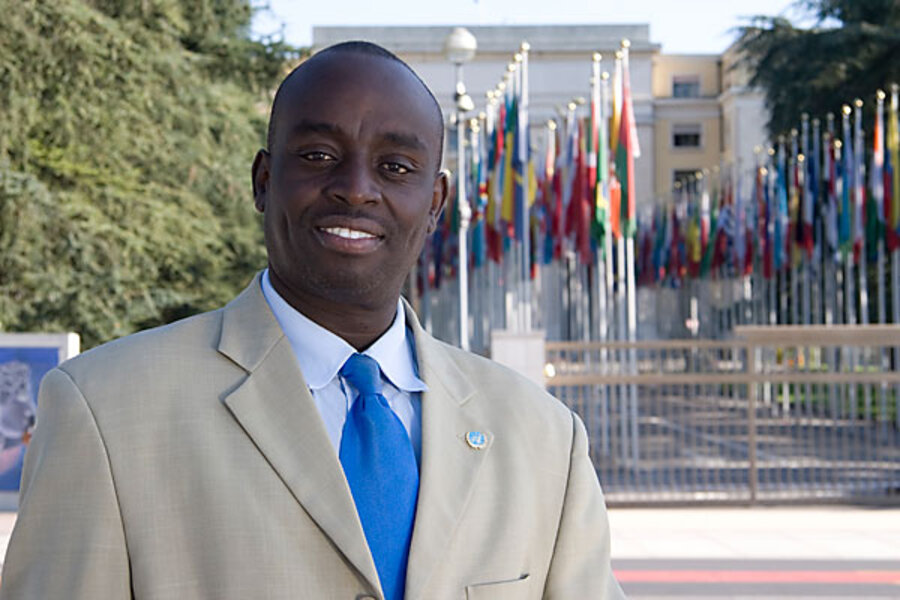Sundance: Glitz gets low profile as festival goes back to basics
Loading...
| Park City, Utah
Glitz is out, art is in. Not just any old art – cutting-edge art. This is the clarion call at this year’s Sundance Film Festival, which kicked off Jan. 21 and wraps this weekend.
Just in case festivalgoers aren’t getting the message, screenings are routinely preceded by onscreen exhortations to rebel. The word “buck” is a mainstay. The festival program guide begins, “This is the renewed rebellion. This is the recharged fight against the establishment of the expected. This is the rebirth of the battle for brave new ideas.” In other words, don’t expect, as in the past, to see Paris Hilton in her parka slinking into a stretch Hummer. It’s back-to-basics time for the largest, and also the coldest, indie film festival in the world.
One might take the cynical view that the recession, and not a higher calling, has something to do with this scaling-back mentality. But it’s certainly been true over the years that Sundance, in ski-mecca Park City, Utah, has doubled as a romping ground for the terminally hip. John Cooper, Sundance’s new director, is looking to end all that.
It was bound to happen anyway. The body count of high-rollers and studio-exec types, for example, is down this year, and so is the consequent star wattage. In the old days, the success of the festival was often judged, to its detriment, by the number of sales it racked up. Now buyers are cautious, and there are fewer of them. Many of the studio “specialty” divisions, which were set up to distribute small-scale offbeat fare, have closed down or been marginalized.
But in the end, Sundance is always about the movies, and, to my eyes, this year’s lineup – or at least the 15 feature films I saw out of the more than 100 that were screened – was about on par with other years: some standouts, some sludge.
The standouts were, as usual, disproportionately documentaries. This makes sense. Documentary filmmakers are often seized by a subject – they’re certainly not seized by the prospect of a big payday – and the passion shows.
Amir Bar-Lev’s “The Tillman Story,” for example, is about Pat Tillman, who gave up a lucrative pro football career to become an Army ranger in 2002 and was subsequently killed in Afghanistan by friendly fire (and not by opposing forces, as originally reported). The US military, attempting to turn Tillman into an action-hero poster boy, initially covered up the circumstances of Tillman’s death. In large part because of the efforts of his mother, Dannie, the truth came out. Dannie, a diminutive woman with a large-scale presence, attended the postscreening discussion, and she refused, as she also does in the film, to turn her son into a saint. Her position is unwavering: It is enough that he was a human being. Bar-Lev bemoaned the fact that, in today’s plugged-in world, everything has to be laid bare. The Tillman family, he feels, “was not allowed to grieve in private. Pat’s symbolism was more important than their grief.”
Another powerful documentary is Jennifer Arnold’s “A Small Act,” which is about Chris Mburu, a poor Kenyan boy who, because his primary and secondary school education was sponsored by an anonymous Swedish woman, became a Harvard-educated human rights lawyer for the United Nations and went on to found his own scholarship fund. The woman, Hilde Beck, now in her 80s, is, it turns out, a Holocaust survivor. When she and Mburu finally meet, we see it on film. We see much else, too. Arnold follows the stories of three Kenyan primary school classmates as they attempt to qualify for scholarships, and their journey is seemingly no less insurmountable than Mburu’s was. As Arnold said in a postscreening interview, the prospects for poor Kenyan schoolchildren who do not advance academically is bleak: Within two years of dropping out of school, the girls become pregnant. The boys become servants or guards for the wealthy. And so the cycle of impoverishment continues.
I did get to meet Hilde Beck at a dinner reception for documentary filmmakers. For someone who claims to disdain the spotlight, this under-five-foot dynamo was having a high old time. She even invited me to visit her in Sweden. I may take her up on it.
There were other standout documentaries. Leon Gast’s “Smash His Camera” focuses on Ron Galella, the now 78-year-old paparazzo best known for provoking Jackie Onassis into serving him with a restraining order. He also once had his jaw broken by Marlon Brando. Such are the wages of fame. Galella is a charming and disarming camera subject, which is surprising given that he’s essentially a species of stalker. I asked him after the screening if he preferred to shoot his subjects – I almost said “victims” – with or without their cooperation. “What I look for is the candid,” he said. I think I detected a half smile.
The title of Alex Gibney’s “Casino Jack and the United States of Money” pretty much says it all. Now jailed Washington superlobbyist Jack Abramoff’s involvement in everything from native American casinos to Chinese sweatshops is so minutely detailed that, watching this film, I suffered scandal overload. In the wake of Bernie Madoff, Abramoff may seem like old news. But his career, as Gibney makes clear, is a microcosm of what’s wrong with the way we do political business in America, and this is far from old news.
The most buzzed-about movie at Sundance was probably “Catfish,” a microbudget documentary directed by Henry Joost and Ariel Schulman about Ariel’s brother Yaniv, a 24-year-old New York photographer who is contacted on MySpace by an 8-year-old Michigan girl who wants permission to paint one of his photos. This leads to a cyber-romance with the girl’s older sister, but nothing is what it seems in this movie, which is like a cautionary tale for the Facebook generation. It’s a fascinating film but it has its amoral aspects – the directors don’t seem to be entirely aware that they intruded themselves, for the supposed greater good of cinema, into woeful people’s lives.
Of the dramatic films that I saw, and, like everybody else, I missed a slew of likely contenders, the best was probably Nicole Holofcener’s “Please Give,” a pleasant enough comedy about a married Manhattan couple, played by Catherine Keener and Oliver Platt, who resell estate-sale furniture. I’m tempted to call this film Woody Allen Lite, except that, for some time now, Allen’s movies have been pretty Lite, too.
John Wells’s “The Company Men” is the latest in what is clearly a new genre: the layoff movie. Ben Affleck, Chris Cooper, and Tommy Lee Jones star as boardroom casualties in what, at times, resembles a cross between “Up in the Air” (minus the fun parts and the romance) and “Death of a Salesman.” Is this a genre that will catch on with audiences? Maybe only if the downsizing is in 3-D. (My biggest Sundance regret, by the way: Missing “Cane Toads: The Conquest,” the 3-D sequel to “Cane Toads: An Unnatural History.”)
Kevin Asch’s “Holy Rollers” stars Jesse Eisenberg as a naive Hasid who ends up smuggling Ecstasy between Amsterdam and New York. This is one of those “inspired by a true story” movies that never rings true.
And then there is the ever-present roster of good performances in so-so movies. Derek Cianfrance’s “Blue Valentine” has two of our finest young actors, Ryan Gosling and Michelle Williams, battling it out as a dysfunctional married couple. The chronology of their tribulations is deliberately jumbled, for that arty effect. “Howl,” the dramatic feature directed by Rob Epstein and Jeffrey Friedman, which opened the festival, pivots on the famous Allen Ginsberg poem and stars James Franco, surprisingly well cast, as the young poet. A chunk of the movie is taken up with Ginsberg’s coffeehouse recitation of “Howl,” but the filmmakers wreck these sequences by inserting animated imaginings over Ginsberg’s words – which hold up quite well all on their own, thank you very much.
Floria Sigismondi’s “The Runaways,” about the short-lived ’70s girl band, has the usual faults of most movies about the drug-rock scene – it makes depravity seem boring – but it proves that (a) Dakota Fanning, as lead singer Cherie Currie, can act, and (b) Kristen Stewart, as Joan Jett (who also performed at Sundance) can be hard-edged as well as “Twilight”-soft.
As for the so-self-indulgent-it-makes-your-teeth-ache “Hesher,” starring Joseph Gordon-Levitt as a stoner loner who insinuates himself into a dysfunctional – what else? – family, it validates my strong suspicion that somewhere out there a computer program exists for concocting Sundance movies. Bad Sundance movies. (I’m suspicious, by the way, of the rousing applause that emanated from one corner of the theater after the “Hesher” screening. Filmmakers and distributors are not above packing the house with partisan cheerers.)
Even good Sundance movies often have a difficult time being seen once the festival ends. Buzz fades; distributors move on. Perhaps the best piece of “rebellion” to emerge from this year’s festival was something called Sundance Selects, in which, on the day of their première, three features from the lineup were made available on-demand through a branded platform of cable and satellite systems reaching 40 million homes throughout America. Also, eight films traveled to eight arthouse theaters in major cities around the country for a one-night showing on Jan. 28, which included a Q-and-A session with the filmmakers.
The thinking behind all this is clear: At a time when quality independent movies are increasingly homeless, and the coverage of these films increasingly pared back in the mainstream press, film festivals have to take a more activist position.
This is the kind of rebellion I can subscribe to. When I rave about a movie, I want to know that people can see it.









